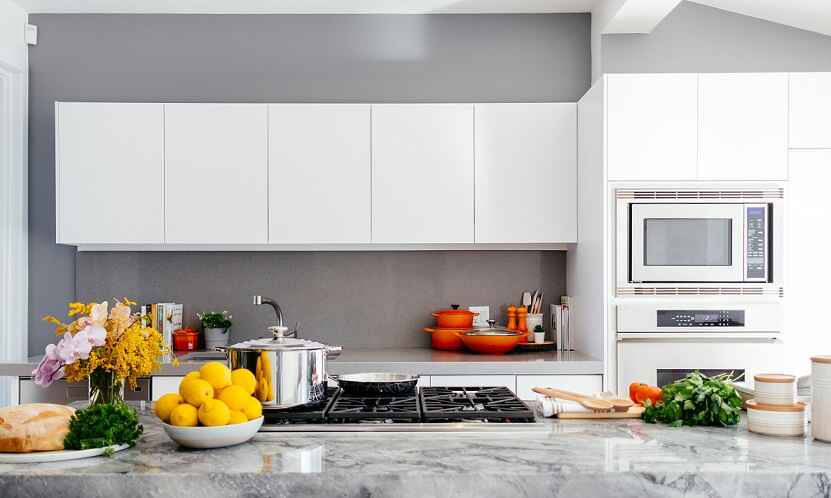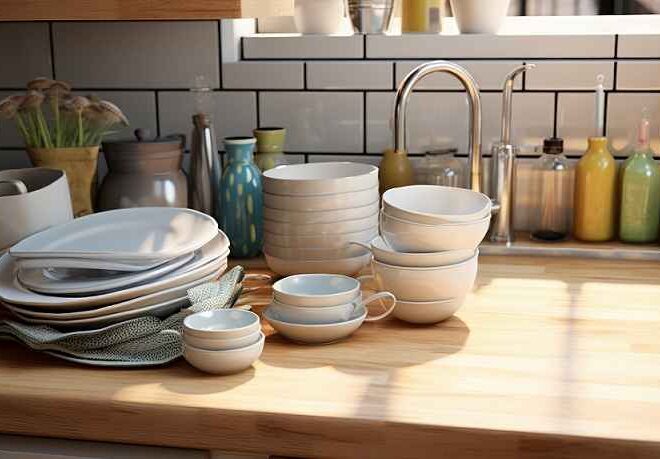
Creating Zones: How to Strategically Fill Your Wide Kitchen for Efficiency
Welcome to the ultimate guide for transforming your wide kitchen into a culinary powerhouse! If you’ve ever felt overwhelmed by the sheer amount of space you have, or found yourself running around in circles trying to locate that elusive spatula while dinner sizzles on the stove, this post is for you. Imagine stepping into a kitchen where everything has its place—where cooking becomes a choreographed dance rather than a frantic scramble. By strategically creating zones tailored to your cooking habits and lifestyle, you can maximize both functionality and flow in one of the most important spaces in your home. Let’s dive into how to craft an efficient oasis that not only looks stunning but makes every meal prep feel effortless!
Introduction to kitchen efficiency and the concept of zones
A wide kitchen is a dream for many home chefs. With ample space to move around, it offers endless possibilities for creativity and efficiency. However, simply having a large area isn’t enough to guarantee an organized cooking experience. That’s where the concept of creating zones comes into play. By strategically filling your wide kitchen with designated areas for different tasks, you can streamline your workflow and make meal prep more enjoyable.
Imagine seamlessly transitioning from chopping vegetables at your prepping zone to sizzling up dinner in the cooking zone without any unnecessary clutter or chaos. In this blog post, we’ll explore how to assess your kitchen’s layout effectively and identify distinct zones that cater specifically to your needs. Let’s dive into transforming that wide kitchen into a hub of efficiency!
Assessing your kitchen’s layout and size
Before diving into creating zones, take a moment to assess your kitchen’s layout and size. Understanding the dimensions is crucial for maximizing efficiency.
Start by measuring key areas: countertops, floor space, and cabinet heights. Pay attention to door swings and traffic flow; these factors can affect how you organize each zone.
Visualize where natural light enters. A well-lit kitchen enhances mood and functionality.
Consider the workflow between different areas. The cooking zone should be close to prepping for seamless transitions while keeping storage within reach reduces unnecessary movement.
Lastly, think about any architectural features like islands or built-in shelving that could influence your design choices. These elements can serve as focal points or functional spaces in your wide kitchen layout.
Identifying the different zones in a wide kitchen (cooking, prepping, cleaning, storage)
In a wide kitchen, zoning is key to maximizing efficiency. Each zone serves a unique purpose and contributes to a seamless cooking experience.
The cooking zone centers around your stove, oven, and other appliances. Keep pots, pans, and frequently used utensils within arm’s reach for quick access during meal prep.
Next comes the prepping zone. This area should be spacious and well-equipped with cutting boards, knives, and mixing bowls. Organizing these tools nearby streamlines your workflow when chopping vegetables or assembling dishes.
The cleaning zone revolves around the sink and dishwasher. Storing dish soap, sponges, and towels close by ensures that tidying up happens effortlessly after each culinary adventure.
Lastly, the storage zone holds all your ingredients and kitchenware. Utilize cabinets efficiently while incorporating vertical space through shelves or hooks to keep everything organized without cluttering countertops.
Tips for organizing each zone
For the cooking zone, consider the flow of meal preparation. Place frequently used appliances like your stove and microwave within easy reach. Keep utensils in a drawer near the prep space for quick access.
In the prepping area, maximize counter space by using cutting boards that can slide over sinks. Store essential tools such as knives and mixing bowls nearby to reduce clutter. Use clear containers for ingredients—visibility helps streamline your workflow.
Lastly, focus on vertical storage in your storage zone. Utilize wall-mounted racks or shelving units to keep items accessible but off countertops. Regularly declutter this area to maintain an organized environment that encourages productivity.
-
Cooking zone: placement of appliances and utensils
The cooking zone is the heart of your wide kitchen. It’s essential to arrange appliances and utensils for seamless workflow.
Start by positioning larger appliances—like your stove, oven, and microwave—within easy reach. A triangle layout between these key players enhances efficiency during meal prep.
Next, consider utensil placement. Use drawers or containers close to the cooking surface for spatulas, tongs, and knives. This minimizes movement while you work.
Don’t forget about vertical space! Magnetic strips can hold knives on the wall instead of cluttering counters with knife blocks.
Additionally, invest in a pull-out shelf for frequently used spices and oils near the stove. This way, everything you need is right at your fingertips when inspiration strikes in the kitchen.
Creating a thoughtful arrangement encourages creativity while cooking without unnecessary distractions or delays.
-
Prepping zone: maximizing counter space and storage solutions
The prepping zone is crucial for any wide kitchen. It’s where the magic of meal preparation happens, so optimizing this space is essential.
Start by assessing your counter space. Clear off anything non-essential to create a clean workspace. Use drawer dividers and trays to keep utensils organized and within reach. This reduces clutter, making your tasks more efficient.
Consider incorporating pull-out shelves or baskets in your cabinets. These solutions maximize storage while providing easy access to ingredients and tools when you need them most.
Magnetic strips are another clever idea. Attach them under cabinets for knives or metal measuring cups, freeing up valuable counter top real estate.
Finally, pegboards can transform blank walls into functional storage areas for pots, pans, and cooking gadgets. This not only looks stylish but also keeps everything visible and accessible during prep time.
-
Cleaning zone: keeping supplies easily accessible and efficient use of sink/dishwasher area
The cleaning zone is crucial in a wide kitchen. This area needs to be organized for maximum efficiency.
Start by placing your sink and dishwasher close together. This minimizes the distance you travel when rinsing dishes or loading the dishwasher.
Underneath the sink, keep all essential supplies within arm’s reach. Store dish soaps, scrubbers, and sponges in a caddy or small bin for easy access.
Consider using pull-out shelves or drawers for larger items like trash bins and recycling containers. It keeps everything tidy while still being functional.
Another tip is to hang frequently used tools on hooks nearby. Items like dish towels and brushes should never be too far away from where they are needed most.
By streamlining this space, you’ll transform how you clean up after meals—making it less of a chore and more of an effortless task that fits seamlessly into your cooking routine.
-
Storage zone: utilizing vertical storage and decluttering unnecessary items
The storage zone is crucial in a wide kitchen. It’s where organization meets efficiency.
Start by assessing your cabinets and shelves. Are there items you rarely use?
Vertical storage offers an effective solution for utilizing every inch of your kitchen. Install shelving above countertops or opt for hanging racks to keep pots, pans, and utensils within reach yet out of the way.
Use baskets and bins on shelves to categorize smaller items like spices or gadgets. Labeling these containers can save time when searching for specific tools during meal prep.
Open shelving can also enhance accessibility while showcasing beautiful dishware or cookbooks as decorative elements. Embrace the idea that less is more; it not only keeps your kitchen tidy but creates a serene atmosphere conducive to culinary exploration.
Examples of successful wide kitchen layouts with designated zones
Successful wide kitchen layouts often showcase well-defined zones that enhance both function and flow.
One popular design includes a U-shaped layout, where the cooking zone features a central island equipped with a stovetop. Surrounding this area are prep stations with ample counter space on either side, allowing for seamless meal preparation.
Another effective example is an L-shaped kitchen, which cleverly separates the cleaning zone from prepping and cooking areas. A deep sink positioned near a dishwasher minimizes movement during cleanup time.
Open shelving can serve as storage in these designs, showcasing frequently used items while keeping them accessible. This not only organizes but also adds personality to the space.
Integrating cozy seating within these layouts encourages interaction while maintaining efficiency across all zones, making every kitchen gathering enjoyable and productive.
Potential challenges and solutions for smaller kitchens with limited space
Smaller kitchens often present unique challenges, especially when it comes to creating efficient zones. Limited space can make it tough to designate areas for cooking, prepping, cleaning, and storage.
One effective solution is to use multi-functional furniture. A kitchen island with built-in storage can serve as both a prep area and a dining spot. This dual purpose helps maximize utility without overcrowding.
Vertical storage is another game-changer. Use wall-mounted shelves or hanging racks to keep essentials within reach while freeing up precious counter space.
Consider investing in collapsible utensils or appliances that can be tucked away when not in use. This keeps surfaces clear and organized.
Finally, prioritize decluttering regularly. Assess what you truly need in your kitchen and remove items that don’t contribute to your daily routine or efficiency. Less clutter means more room for the zones you create!
Conclusion: benefits of creating zones in a wide kitchen for efficiency and productivity.
Creating designated zones in a wide kitchen can significantly enhance both efficiency and productivity. By organizing your space into specific areas for cooking, prepping, cleaning, and storage, you make the most of your available room.
With clearly defined zones, you’ll find that tasks flow more smoothly. Cooking becomes less chaotic when everything is within reach. Prepping food feels easier with ample counter space dedicated solely to it. Cleaning up after meals turns into a breeze when supplies are organized nearby.
This strategic approach means no more running back and forth across the kitchen looking for utensils or ingredients. Instead, you can focus on creating delicious meals without unnecessary distractions.
Utilizing vertical storage helps keep clutter at bay while ensuring that all your tools are accessible yet out of sight until needed. The result? A tidy workspace where culinary creativity thrives.
Implementing these strategies transforms not just the look but also the functionality of your wide kitchen—making it an inviting place for family gatherings or quiet dinners alike. Embracing this method could lead to a more enjoyable cooking experience filled with inspiration instead of frustration.


